 |
|
Hi, you're in the Archives, July 2009 - Part 1 |
|
|
|
|
 |
| |
|
July
13, 2009 |
|
 |
| CONCERT
REVIEW by Nick Morgan |
JARVIS
COCKER
Troxy, Limehouse,
London, June 17th 2009 |
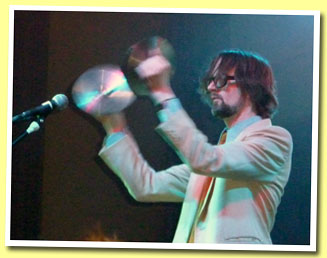 |
| Jarvis
Cocker has released a
new album, which in the spirit of
the times has turned its back on the
melodic (although not the melancholic),
and rejected sophistication and complexity
in favour of a stripped-down rock
and roll feel, perhaps partly inspired
by recording engineer Steve
Albini. |
| This,
you may recall, was as predicted when
he previewed songs from the new album
at the end of last year at the Shepherd’s
Bush Empire. The reception for Further
Complications has been mixed, some
rejecting its rawness as a backward
step, others embracing it. Not a few
have suggested that the music, like
the album’s title, reflects
a difficult time in Cocker’s
personal affairs, if not a mid-life
crisis for the 46-year-old. |
| On
this short UK tour to promote the
album, Cocker has turned away from
the West and brought us to Troxy,
the rather unlikely venue (and former
theatre of dreams) in the East End’s
Limehouse, once in the heart of the
capital’s docklands, and the
place where cholera first struck in
London in 1832, as Cocker reminds
us. This last fact was about the only
thing all evening that diverted the
two sturdy security guards in front
of us from their task of managing
access to the mosh, and keeping the
path to the raised area of the ground
floor clear. In fact, the security
are everywhere; it’s a hugely
over-staffed venue, which, nice though
the carpeted floors are, could do
with investing a bit more in some
basic facilities (the woefully inadequate
three urinals guarantee lengthy queues
and ill-humour all evening). |
|
|
 |
| But
the sound is pretty good, or certainly
good enough for Jarvis’s new
stuff, driven by the two guitarists
Tim McColl and Martin Craft. The set
begins in uncompromising fashion with
‘Angela’, followed by
the ‘spare post-industrial rock’
(as my notebook says) of ‘Further
complications’, and doesn’t
look back. |
| Cocker
joins the stage brandishing a cane,
then jumps, kicks, postures and philosophises
when he’s not bellowing out
his lyrics, which despite the stripped-back
sound retain his trademark wit, sophistry
and slyness, and not a tad of explicit
sexuality (‘Fuckingsong’).
At its best the set is glorious; think
eighty-five per cent Jarvis Cocker,
ten per cent Psychedelic Furs (particularly
when the saxophone is introduced)
and five per cent rocking Roxy Music
and you might get an idea. The set
moved between the new album and some
of the highlights from his first eponymous
album, ‘Big Julie’, ‘Black
magic’, and in the encore ‘Fat
kids’. And for the most part
it’s all very good stuff, though
‘You’re in my eyes’,
an inexplicably self-indulgent disco
pastiche, is as weak live as it is
on the album. Still it’s at
least an eight out of ten gig, which
is good enough for me. - Nick
Morgan (photographs by Kate) |
 |
| Listen:
Jarvis
Cocker on MySpace |
| PETE
McPEAT AND JACK WASHBACK on holidays
in St Tropez |
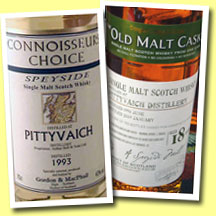 |
TASTING
– TWO PITTYVAICH |
Pittyvaich
1993/2005 (43%, Gordon & MacPhail,
Connoisseur's Choice)
 Pittyvaich was built in 1975,
stopped distilling in 1993 and was
demolished in 2002. Wooosh! This one
is from the distillery’s last
year. Colour: white wine. Nose: typical
young Speysider but with a little
more smoke than usual. ‘Smoked
porridge’ and lemon-sprinkled
apple compote, beer and baker’s
yeast. We’re not extremely far
from some herbs-flavoured vodkas such
as Zubrowka. Mouth: easy-going fruity
and grassy Speysider at the attack,
getting more porridgy and more on
fruit drops. Jell-O. Finish: shortish
and weakish, grassy. Pears. Comments:
not unpleasant (I couldn’t be
more PC than that, could I!) SGP:331
- 73 points.
Pittyvaich was built in 1975,
stopped distilling in 1993 and was
demolished in 2002. Wooosh! This one
is from the distillery’s last
year. Colour: white wine. Nose: typical
young Speysider but with a little
more smoke than usual. ‘Smoked
porridge’ and lemon-sprinkled
apple compote, beer and baker’s
yeast. We’re not extremely far
from some herbs-flavoured vodkas such
as Zubrowka. Mouth: easy-going fruity
and grassy Speysider at the attack,
getting more porridgy and more on
fruit drops. Jell-O. Finish: shortish
and weakish, grassy. Pears. Comments:
not unpleasant (I couldn’t be
more PC than that, could I!) SGP:331
- 73 points. |
Pittyvaich
18 yo 1990/2009 (50%, Douglas Laing
OMC, sherry, 703 bottles)
 Colour: amber. Nose: ‘nice’
average sherry with whiffs of gunpowder,
struck matches, roasted chestnuts
and burnt bread and cake but the sulphury
notes grow bigger over time, without
becoming a huge problem (no ‘eggs’,
no ‘truffles’). Gets then
rather less pleasant, with notes of
orange squash (Fanta, really) and
ginger tonic as well as quite some
rubber (bands). Very average. Mouth:
the attack is okay but sometimes these
notes of orangeade just don’t
work well with sherry. Green vegetables,
apple vinegar. Finish: rather long
but the sulphur comes back. Odd. Comments:
cheapo/barely okayish in my opinion.
SGP:431 – 70 points.
Colour: amber. Nose: ‘nice’
average sherry with whiffs of gunpowder,
struck matches, roasted chestnuts
and burnt bread and cake but the sulphury
notes grow bigger over time, without
becoming a huge problem (no ‘eggs’,
no ‘truffles’). Gets then
rather less pleasant, with notes of
orange squash (Fanta, really) and
ginger tonic as well as quite some
rubber (bands). Very average. Mouth:
the attack is okay but sometimes these
notes of orangeade just don’t
work well with sherry. Green vegetables,
apple vinegar. Finish: rather long
but the sulphur comes back. Odd. Comments:
cheapo/barely okayish in my opinion.
SGP:431 – 70 points.
|
| |
|
July
10, 2009 |
|
 |
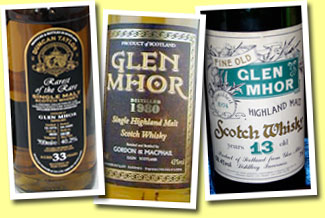 |
TASTING
– MORE GLEN MHOR (Serge!)
Glen
Mhor (now Telford Retail Park!)
is one the best examples of old
school Highlanders, sometimes a
tad shaky in my opinion but always
interesting and, above all, always
funny to try. In other words, exactly
the opposite of most recent modern
malt whiskies with ‘wood technology
inside’. |
Glen
Mhor 33 yo 1975/2009 (40.2%, Duncan
Taylor, Rarest of the Rare, cask #4035,
250 bottles)  Colour: gold. Nose: smooth, almost
a little ethereal (which isn’t
very ‘Glen Mhor’ to say
the least) but wonderfully waxy and
grassy at first nosing, with also
distinct notes of green bananas (skin)
and fresh almonds. Goes on with notes
of green tea, something like asparagus,
custard powder, hints of shoe polish
and cut grass. Certainly less fruity
than most of its sister casks from
the same bottler’s, but maybe
even more interesting for its ‘oldhighlandsness’.
Let’s only hope the palate will
last the course. Mouth: well, it does.
Not tired, not overly woody, rather
wonderfully leafy and herbal, with
notes of green tea (lots), liquorice
wood and a little horseradish, then
fruits, mainly strawberries and gooseberries,
and maybe just a little paper/cardboard
although it never gets drying. Touches
of nutmeg and cinnamon. Finish: astonishingly
long, with citrusy notes, ginger and
lemon balm. Unexpected! Comments:
not a beefy/shaky Glen Mhor, rather
a grassy one and it is very, very
good. Perfect body at only 40.2% vol.
DT, do you have more 1975 Glen Mhor?
SGP:362 - 87 points.
Colour: gold. Nose: smooth, almost
a little ethereal (which isn’t
very ‘Glen Mhor’ to say
the least) but wonderfully waxy and
grassy at first nosing, with also
distinct notes of green bananas (skin)
and fresh almonds. Goes on with notes
of green tea, something like asparagus,
custard powder, hints of shoe polish
and cut grass. Certainly less fruity
than most of its sister casks from
the same bottler’s, but maybe
even more interesting for its ‘oldhighlandsness’.
Let’s only hope the palate will
last the course. Mouth: well, it does.
Not tired, not overly woody, rather
wonderfully leafy and herbal, with
notes of green tea (lots), liquorice
wood and a little horseradish, then
fruits, mainly strawberries and gooseberries,
and maybe just a little paper/cardboard
although it never gets drying. Touches
of nutmeg and cinnamon. Finish: astonishingly
long, with citrusy notes, ginger and
lemon balm. Unexpected! Comments:
not a beefy/shaky Glen Mhor, rather
a grassy one and it is very, very
good. Perfect body at only 40.2% vol.
DT, do you have more 1975 Glen Mhor?
SGP:362 - 87 points. |
Glen
Mhor 1980/2007 (43%, Gordon &
MacPhail, licensed bottling)
 Many Glen Mhors by G&M have been,
let’s say ‘strange’,
but some were also brilliant. Let’s
see… Colour: straw. Nose: well,
strange it is. Starts on rather huge
herbal notes (a lot of parsley) and
gets then rather leathery and meaty,
with some cured ham and then notes
of wet newspaper and graphite oil.
Ink? Certainly a malt like no other!
Some vanilla coming through later
on, almonds after fifteen minutes.
Mouth: full bodied and certainly straighter
than on the nose and in that sense
closer to the 1975. Leaves, chlorophyll,
herbs liqueur, chives, liquorice wood
and then signs of youth (?) such as
a little porridge, beer, baker’s
yeast… Too bad it’s also
a little cardboardy. Finish: rather
long, with a little more fruits. Bitter
oranges. Comments: very decent and
very fairly priced, the easiest/cheapest
way to try Glen Mhor if you never
did. SGP:241 - 84 points.
Many Glen Mhors by G&M have been,
let’s say ‘strange’,
but some were also brilliant. Let’s
see… Colour: straw. Nose: well,
strange it is. Starts on rather huge
herbal notes (a lot of parsley) and
gets then rather leathery and meaty,
with some cured ham and then notes
of wet newspaper and graphite oil.
Ink? Certainly a malt like no other!
Some vanilla coming through later
on, almonds after fifteen minutes.
Mouth: full bodied and certainly straighter
than on the nose and in that sense
closer to the 1975. Leaves, chlorophyll,
herbs liqueur, chives, liquorice wood
and then signs of youth (?) such as
a little porridge, beer, baker’s
yeast… Too bad it’s also
a little cardboardy. Finish: rather
long, with a little more fruits. Bitter
oranges. Comments: very decent and
very fairly priced, the easiest/cheapest
way to try Glen Mhor if you never
did. SGP:241 - 84 points. |
Glen
Mhor 13 yo 1974 (58.4%, Sestante,
75cl)  Colour: gold. Nose: what is this?
How should I put this? Imagine a mixture
of crushed strawberries with pieces
of new leather, chalk and bits of
new plastic (supermarket plastic bag
– remember?), plus a few drop
of diesel oil on top of that. Very,
very strange, let’s see what
happens with water. With water: oh!
Did they distil grass? Not one single
note of fruits or anything sweet and
mellow… Amazing and, I must
say, spectacular. Mouth (neat): it
is a tad more affable than on the
nose when undiluted but it’s
still a little hard. Over-infused
green tea, fresh walnuts, green apples,
lime (yup, all green) and… green
pepper. Bites your tongue a bit, or
rather kind of catches it in a pincer
movement if you see what I mean. Gets
then better and better and better
(and better), with more marzipan,
lapsang souchong tea, cardamom and
a little cumin. With water: fantastic!
Old Tarragona green chartreuse, well
bottle-aged Bénédictine,
cough syrup (adult version), Danziger
Goldwasser (check that on google)…
An amazing herbal symphony. Finish:
very long, and very herbal. Comments:
as entertaining as a movie by Quenn’tiiiinn’
but certainly not one to pour your
new neighbours, unless they were originally
living in Inverness. Having said that,
this very odd bottling is totally
introvabile. SGP:272 - 88
points.
Colour: gold. Nose: what is this?
How should I put this? Imagine a mixture
of crushed strawberries with pieces
of new leather, chalk and bits of
new plastic (supermarket plastic bag
– remember?), plus a few drop
of diesel oil on top of that. Very,
very strange, let’s see what
happens with water. With water: oh!
Did they distil grass? Not one single
note of fruits or anything sweet and
mellow… Amazing and, I must
say, spectacular. Mouth (neat): it
is a tad more affable than on the
nose when undiluted but it’s
still a little hard. Over-infused
green tea, fresh walnuts, green apples,
lime (yup, all green) and… green
pepper. Bites your tongue a bit, or
rather kind of catches it in a pincer
movement if you see what I mean. Gets
then better and better and better
(and better), with more marzipan,
lapsang souchong tea, cardamom and
a little cumin. With water: fantastic!
Old Tarragona green chartreuse, well
bottle-aged Bénédictine,
cough syrup (adult version), Danziger
Goldwasser (check that on google)…
An amazing herbal symphony. Finish:
very long, and very herbal. Comments:
as entertaining as a movie by Quenn’tiiiinn’
but certainly not one to pour your
new neighbours, unless they were originally
living in Inverness. Having said that,
this very odd bottling is totally
introvabile. SGP:272 - 88
points. |
| STEPHANE
THE MAD MALT MIXOLOGIST |

|
proposes
his Summertime malt cocktails
"Battlehill
Fizz" |
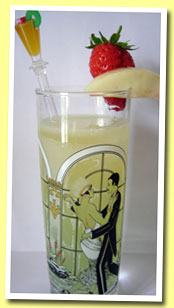 |
Pour
into a highball:
- 6cl young and fruity single malt
of the Duncan Taylor's "Battlehill"
range (e.g. Imperial 9 yo)
- 2cl melocoton (white peach) liqueur
- 1 lime juice
- finish with Perrier
Add two ice cubes, decorate with a
chunk of peach, a strawberry or/and
any summer fruit you like.
You may add a dash of mint liqueur
to strengthen its freshness.
Fizzes and juleps are my favourite
types of cocktails when temperatures
grow higher and higher. |
MUSIC
- Recommended listening:
Long time no have Hammond B3 so
let's listen to the wonderful Barbara
Dennerlein playing
Bo-Peep.
From: Take off!
Please buy all of barbara Dennerlein's
music! |
 |
| |
|
July
9, 2009 |
|
 |
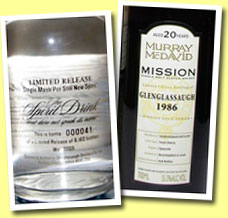 |
TASTING
– TWO EXTREME GLENGLASSAUGH
I first thought I’d try the
new newmake HtoH with some newmake
from another distillery but then
I thought it would be ‘funnier’
(well) to compare it to a very cask-influenced
Glenglassaugh, so that we could
have two extremes. Yes, fun over
self-education! |
Glenglassaugh
'The Spirit Drink that dare not speak
its name' (50%, OB, May 2009, Limited
Release, 8160 bottles)
 Plain newmake, no Scotch whisky. It
seems that there are various batches,
some bearing Months and bottle numbers
and some not. This one is numbered.
It’s not exactly a first as
Samaroli already had newmake (Longrow)
quite some years ago, Kilchoman too
and maybe others. Colour: as white
as vodka. Nose: well well well, this
reminds us of the many visits we did
at Scottish distilleries, minus the
distilleries ;-). What’s sure
is that it’s very clean spirit,
not extravagantly fruity but fresh
and certainly not beer-ish nor feinty.
It’s not aromatically complex
and it’s hard to come up with
proper descriptors, all I can say
is that it’s pleasant. Very
faint smokiness and just tiny-wee
hints of ham and soap. With water:
a little more grass and mash but it’s
still not beer-ish. Extremely clean.
Mouth (neat): more fruits than on
the nose. Raspberry jam, Jell-O, tinned
pineapples and Haribo bears, all that
soaked in white rum. Better than it
sounds ;-). With water: more of the
same plus notes of pears. Finish:
medium long, clean, very fruity. Just
a little beer in the aftertaste. Comments:
we won’t comment on the meaning
of such a bottle, after all we’re
only into whisky tasting (not commenting)
on this blog, which isn’t even
a true blog by the way. What’s
sure is that it’s probably the
very best vodka ever, even better
than the malt vodkas that one can
find here and there. I was ready to
smash this bottling because it looked
like a pure marketing stunt but I
must say I really enjoyed it. Better
than many matured malts in my book!
SGP:730 - 80 points.
(and thank you, Jean-Marc)
Plain newmake, no Scotch whisky. It
seems that there are various batches,
some bearing Months and bottle numbers
and some not. This one is numbered.
It’s not exactly a first as
Samaroli already had newmake (Longrow)
quite some years ago, Kilchoman too
and maybe others. Colour: as white
as vodka. Nose: well well well, this
reminds us of the many visits we did
at Scottish distilleries, minus the
distilleries ;-). What’s sure
is that it’s very clean spirit,
not extravagantly fruity but fresh
and certainly not beer-ish nor feinty.
It’s not aromatically complex
and it’s hard to come up with
proper descriptors, all I can say
is that it’s pleasant. Very
faint smokiness and just tiny-wee
hints of ham and soap. With water:
a little more grass and mash but it’s
still not beer-ish. Extremely clean.
Mouth (neat): more fruits than on
the nose. Raspberry jam, Jell-O, tinned
pineapples and Haribo bears, all that
soaked in white rum. Better than it
sounds ;-). With water: more of the
same plus notes of pears. Finish:
medium long, clean, very fruity. Just
a little beer in the aftertaste. Comments:
we won’t comment on the meaning
of such a bottle, after all we’re
only into whisky tasting (not commenting)
on this blog, which isn’t even
a true blog by the way. What’s
sure is that it’s probably the
very best vodka ever, even better
than the malt vodkas that one can
find here and there. I was ready to
smash this bottling because it looked
like a pure marketing stunt but I
must say I really enjoyed it. Better
than many matured malts in my book!
SGP:730 - 80 points.
(and thank you, Jean-Marc) |
Glenglassaugh
20 yo 1986/2006 (55.3%, Murray McDavid,
Mission Gold, Fresh Sherry Cask, 608
bottles)  Colour: reddish mahogany. Nose: a
rather unusual heavily sherried whisky
at first nosing, smelling just like
some vintage Maury (vin doux naturel)
– and big time! Heavy notes
of raisins combined with spearmint
and coffee-schnapps, then loads of
marmalade and strawberry jam plus
chestnut purée, blackberry
jam and a little white chocolate.
I guess this is what one calls an
emphatic whisky. With water: more
leather, varnish, a little turpentine
and bitter oranges. Hints of old golden
rhum agricole. Mouth (neat): isn’t
it funny that we get the same kind
of extreme fruitiness as in the newmake
here? Bags of bubblegum and jars of
strawberry jam, then more classical
sherry notes such as raisins again,
marmalade, chocolate and a little
clove in the background. Thick, but
not exactly heavy. With water: the
odd notes of orangeade (say Fanta)
but other that that, it’s clean,
heavy sweet sherry galore. Sultanas,
crystallised oranges, tangerine liqueur,
stracciatella and fudge. Finish: long,
a tad more roasted. Notes of cough
syrup in the aftertaste. Comments:
very good, playful, a tad heavy but
not overloaded. And certainly demonstrative!
SGP:631 - 87 points.
(and thank you, Konstantin)
Colour: reddish mahogany. Nose: a
rather unusual heavily sherried whisky
at first nosing, smelling just like
some vintage Maury (vin doux naturel)
– and big time! Heavy notes
of raisins combined with spearmint
and coffee-schnapps, then loads of
marmalade and strawberry jam plus
chestnut purée, blackberry
jam and a little white chocolate.
I guess this is what one calls an
emphatic whisky. With water: more
leather, varnish, a little turpentine
and bitter oranges. Hints of old golden
rhum agricole. Mouth (neat): isn’t
it funny that we get the same kind
of extreme fruitiness as in the newmake
here? Bags of bubblegum and jars of
strawberry jam, then more classical
sherry notes such as raisins again,
marmalade, chocolate and a little
clove in the background. Thick, but
not exactly heavy. With water: the
odd notes of orangeade (say Fanta)
but other that that, it’s clean,
heavy sweet sherry galore. Sultanas,
crystallised oranges, tangerine liqueur,
stracciatella and fudge. Finish: long,
a tad more roasted. Notes of cough
syrup in the aftertaste. Comments:
very good, playful, a tad heavy but
not overloaded. And certainly demonstrative!
SGP:631 - 87 points.
(and thank you, Konstantin) |
MUSIC
- Recommended listening:
Some good P-funk today with Bootsy
Collins featuring George
Clinton & The P-Funk All-Stars
doing Jimi Hendrix's Power
of Soul.
From:
Power Of Soul: A Tribute To Jimi
Hendrix
Please buy Bootsy Collins' music! |
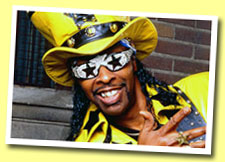 |
| |
|
July
8, 2009 |
|
 |
 |
TASTING
– THREE NEW OLD PULTENEY |
Old
Pulteney 30 yo (44%, OB, 2009)
 This one is a brand new bottling by
the owners, the oldest official Pulteney
ever. It’s ex-American white
oak (bourbon). Colour: straw. Nose:
it’s the trademark brine and
the oak that strike first, in a beautiful
fashion, with lots of apples and tangerines
in the background. After this very
coastal start we get more vanilla
and flower nectar as well as touches
of quince jelly, warm apple pie and
maybe just hints of fresh strawberries
and marshmallows before it gets more
lemony (lemonade). And we’re
finally back on iodine and faint whiffs
of crushed fresh mint leaves. Extremely
‘natural’ and very elegant,
well in the style of our beloved coastal
Northeasterners. Mouth: very good
body at the attack, even more on apples
than on the nose, with the oak soon
to kick in. Ginger and a little cinnamon.
Goes on with notes of vanilla crème
and café latte, then quite
some lemon marmalade and finally a
little salt that starts to play with
your tongue. Touches of ripe strawberries.
The oak grows bigger too (quite some
pepper). Finish: long, firm, on an
oak + lemon + salt + vanilla fudge
combo that works very well. Comments:
some whisky lovers may find that the
rather obvious oakiness is a tad ‘too
much’ but it isn’t my
opinion as it gives the whole an excellent
structure. In other words, the spirit
stands the oak that supports the spirit
(or something like that). The whole
is very, very ‘natural’.
And very recommended! SGP:451
– 91 points.
This one is a brand new bottling by
the owners, the oldest official Pulteney
ever. It’s ex-American white
oak (bourbon). Colour: straw. Nose:
it’s the trademark brine and
the oak that strike first, in a beautiful
fashion, with lots of apples and tangerines
in the background. After this very
coastal start we get more vanilla
and flower nectar as well as touches
of quince jelly, warm apple pie and
maybe just hints of fresh strawberries
and marshmallows before it gets more
lemony (lemonade). And we’re
finally back on iodine and faint whiffs
of crushed fresh mint leaves. Extremely
‘natural’ and very elegant,
well in the style of our beloved coastal
Northeasterners. Mouth: very good
body at the attack, even more on apples
than on the nose, with the oak soon
to kick in. Ginger and a little cinnamon.
Goes on with notes of vanilla crème
and café latte, then quite
some lemon marmalade and finally a
little salt that starts to play with
your tongue. Touches of ripe strawberries.
The oak grows bigger too (quite some
pepper). Finish: long, firm, on an
oak + lemon + salt + vanilla fudge
combo that works very well. Comments:
some whisky lovers may find that the
rather obvious oakiness is a tad ‘too
much’ but it isn’t my
opinion as it gives the whole an excellent
structure. In other words, the spirit
stands the oak that supports the spirit
(or something like that). The whole
is very, very ‘natural’.
And very recommended! SGP:451
– 91 points. |
Pulteney
26 yo 1982/2009 (47.7%, A.D. Rattray,
cask #502, 201 bottles)
 This one from a hogshead. Colour:
pale gold. Nose: this one is much
heavier and kind of rougher than the
new OB, with more oak and many more
mineral notes. Wet limestone, chalk,
ginger, then whiffs of lemonade and
sea breeze again, leather, cut grass,
leaves, roots… Definitely wilder
and less fruity than the OB but well
in the OP tradition. With water: water
doesn’t change its profile mucho,
except for more coastal notes such
as seaweed. Also a little coffee and
roasted nuts. Mouth (neat): we’re
well in the same category as the OB
but once again, it’s all rougher
and bigger, which may well not be
an asset here. Big oak, big white
pepper and quite a ‘greenness’.
Angelica. Gets frankly prickly (pepper
flavoured vodka). With water: oh well,
now it IS beautiful. Very nice notes
of caramelised apples, roasted honey
and green tea. A tad unusual but very
likeable. Finish: long, clean, with
the coastal side coming out. Vanilla-flavoured
clams? (I’m sorry ;-)) Comments:
another very good Pulteney that ‘s
maybe a tad slow when undiluted but
that becomes quite superb with the
addition of a few drops of water.
SGP:361 - 88 points.
This one from a hogshead. Colour:
pale gold. Nose: this one is much
heavier and kind of rougher than the
new OB, with more oak and many more
mineral notes. Wet limestone, chalk,
ginger, then whiffs of lemonade and
sea breeze again, leather, cut grass,
leaves, roots… Definitely wilder
and less fruity than the OB but well
in the OP tradition. With water: water
doesn’t change its profile mucho,
except for more coastal notes such
as seaweed. Also a little coffee and
roasted nuts. Mouth (neat): we’re
well in the same category as the OB
but once again, it’s all rougher
and bigger, which may well not be
an asset here. Big oak, big white
pepper and quite a ‘greenness’.
Angelica. Gets frankly prickly (pepper
flavoured vodka). With water: oh well,
now it IS beautiful. Very nice notes
of caramelised apples, roasted honey
and green tea. A tad unusual but very
likeable. Finish: long, clean, with
the coastal side coming out. Vanilla-flavoured
clams? (I’m sorry ;-)) Comments:
another very good Pulteney that ‘s
maybe a tad slow when undiluted but
that becomes quite superb with the
addition of a few drops of water.
SGP:361 - 88 points. |
Pulteney
18 yo 1990/2009 (57.2%, Cadenhead,
Authentic Collection, 217 bottles)
 Colour: pale gold. Nose: one step
further towards ‘wilderness’
but also these hints of strawberries
and bubblegum that we already found
in the OB. Also more marzipan and
cut apples plus a good deal of oak.
It’s also the less coastal.
Let’s see what happens with
water: wow, this is nice! More mint,
eucalyptus, even a little camphor,
hints of orange blossom water, coconut
liqueur (only faint touches, don’t
worry). High class, maybe just a tad
bourbonny. Mouth (neat): once again,
we’re rather closer to the OB
than to the 1982, with various fruits
encapsulated in quite some oak. Ginger
and strawberries, coconut (the oak
speaks out), vanilla and white pepper.
Funnily drinkable at such high strength.
With water: oh well, here’s
another excellent Pulteney indeed.
Arrak, aniseed, crystallised oranges
and always quite some coconut and
pepper from the oak. Finish: long,
sweet and mildly spicy. Maybe a little
less precise now. Comments: a very
good Pulteney from a very active cask.
The sweetest of them all. SGP:451
- 88 points.
Colour: pale gold. Nose: one step
further towards ‘wilderness’
but also these hints of strawberries
and bubblegum that we already found
in the OB. Also more marzipan and
cut apples plus a good deal of oak.
It’s also the less coastal.
Let’s see what happens with
water: wow, this is nice! More mint,
eucalyptus, even a little camphor,
hints of orange blossom water, coconut
liqueur (only faint touches, don’t
worry). High class, maybe just a tad
bourbonny. Mouth (neat): once again,
we’re rather closer to the OB
than to the 1982, with various fruits
encapsulated in quite some oak. Ginger
and strawberries, coconut (the oak
speaks out), vanilla and white pepper.
Funnily drinkable at such high strength.
With water: oh well, here’s
another excellent Pulteney indeed.
Arrak, aniseed, crystallised oranges
and always quite some coconut and
pepper from the oak. Finish: long,
sweet and mildly spicy. Maybe a little
less precise now. Comments: a very
good Pulteney from a very active cask.
The sweetest of them all. SGP:451
- 88 points. |
| PETE
McPEAT AND JACK WASHBACK on holidays
in St Tropez |
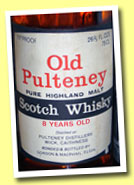 |
And
also Old
Pulteney 8 yo (70° proof, Gordon
& MacPhail, Germany, 1970s)
 Nose: nice smokiness but lacks oomph.
Whiffs of leather. Gets then fruitier
but a tad ‘mundane’ in
style. Light OBE (in case you do not
know yet, that means Old Bottle Effect
in our weird glossary). Mouth: more
cardboardy, a little tired. A little
caramel and a little orange marmalade.
Comments: maybe not the best old OP
ever. One should rather seek the extraterrestrial
100°proof by G&M. SGP:341
– 78 points.
Nose: nice smokiness but lacks oomph.
Whiffs of leather. Gets then fruitier
but a tad ‘mundane’ in
style. Light OBE (in case you do not
know yet, that means Old Bottle Effect
in our weird glossary). Mouth: more
cardboardy, a little tired. A little
caramel and a little orange marmalade.
Comments: maybe not the best old OP
ever. One should rather seek the extraterrestrial
100°proof by G&M. SGP:341
– 78 points. |
MUSIC
- Recommended listening:
Artist: Meshell
Ndegeocello, Yerba
Buena and Ron
Blake
Title: Gentleman
From:
Red Hot & Riot - The Music And
Spirit Of Fela Kuti
Please buy all these people's music. |
 |
| |
|
July
7, 2009 |
|
 |
 |
TASTING
FOUR
VERY OLD MACALLAN
(Or is that only three? Only two?) |
Macallan
18 yo 1966 (43%, OB, +/-1984)
 From one of the good years of the
18, things having got a tad less entrancing
from the late 1970s on. Colour: full
amber. Nose: yes, yes and yes. This
is why The Macallan used to be one
of ‘the grands crus’ of
malt whisky. It’s a rather powerful
whisky, starting compact and ‘focused’
on a lot of marmalade-filled chocolate,
wood smoke and hints of cured ham,
and getting then much wider, doing
what we call ‘the peacock’s
tail’ (I guess you get the image).
We get a rather wonderful ‘half
mustiness’ (old wine cellar),
notes of roasted nuts, something delicately
fragrant (old roses, Joy de Patou),
then more marzipan and baklavas, bergamots
and lime blossom. The smokiness wouldn’t
leave, which only adds to the superb
combo. An epitomically (what?) classy
sherried Speysider. Mouth: punchy,
fruity, peppery, rather less rounded
and than expected at the attack, but
really takes off after a while, with
quite a smokiness, roasted nuts, strawberry
jam, orange zests and cooked honey.
Notes of mead. Brownies. Finish: rather
long, on a pepper/sherry combination
and just a faint dustiness. Comments:
very nice nose and a palate that’s
maybe a little less thrilling, but
the whole is of very high quality.
Do not ask us to compare it with recent
versions of the popular 18yo. SGP:452
- 90 points. (and thanks
to the Gentlemen du Whisky)
From one of the good years of the
18, things having got a tad less entrancing
from the late 1970s on. Colour: full
amber. Nose: yes, yes and yes. This
is why The Macallan used to be one
of ‘the grands crus’ of
malt whisky. It’s a rather powerful
whisky, starting compact and ‘focused’
on a lot of marmalade-filled chocolate,
wood smoke and hints of cured ham,
and getting then much wider, doing
what we call ‘the peacock’s
tail’ (I guess you get the image).
We get a rather wonderful ‘half
mustiness’ (old wine cellar),
notes of roasted nuts, something delicately
fragrant (old roses, Joy de Patou),
then more marzipan and baklavas, bergamots
and lime blossom. The smokiness wouldn’t
leave, which only adds to the superb
combo. An epitomically (what?) classy
sherried Speysider. Mouth: punchy,
fruity, peppery, rather less rounded
and than expected at the attack, but
really takes off after a while, with
quite a smokiness, roasted nuts, strawberry
jam, orange zests and cooked honey.
Notes of mead. Brownies. Finish: rather
long, on a pepper/sherry combination
and just a faint dustiness. Comments:
very nice nose and a palate that’s
maybe a little less thrilling, but
the whole is of very high quality.
Do not ask us to compare it with recent
versions of the popular 18yo. SGP:452
- 90 points. (and thanks
to the Gentlemen du Whisky) |
Macallan
41 yo 1949/1990 (40.4%, Milroys of
Soho, Oak Wood)  These vintages are getting increasingly
rare and you’ll have to hand
out +/-500 Euros if you want to buy
an official Macallan 1949. A miniature,
that is… ;-). Colour: full gold.
Nose: this one is rather different
from the 1966, obviously woodier and
more resinous and less on ‘classy
sherry’ but it’s still
very brilliant whisky on the nose.
More smoke than in the 1966, with
also bold whiffs of rhubarb pie, lemon
marmalade, even ripe kiwis, oranges,
metal (old toolbox), lovage and parsley…
Gets a tad mouldy and plankish but
nothing extreme, really. Great old
Macallan once again. Mouth: perfect!
Curiously medicinal (cough medicine)
but also very jammy, without the much
feared excessive oakiness. Very pleasant
‘dry’ spiciness (cinnamon
and nutmeg), something waxy, notes
of limejuice (very fresh considering
this one’s age) and a lot of
liquorice. Gets finally very honeyed,
with the same notes of mead as in
the 1966. Finish: rather long and
still quite ‘medicinally resinous’
for a Macallan, I guess it all comes
from the wood. Aftertaste maybe a
tad drying. Comments: an oldie that
does taste old but that did not go
over the hill. SGP:442 - 91
points.
These vintages are getting increasingly
rare and you’ll have to hand
out +/-500 Euros if you want to buy
an official Macallan 1949. A miniature,
that is… ;-). Colour: full gold.
Nose: this one is rather different
from the 1966, obviously woodier and
more resinous and less on ‘classy
sherry’ but it’s still
very brilliant whisky on the nose.
More smoke than in the 1966, with
also bold whiffs of rhubarb pie, lemon
marmalade, even ripe kiwis, oranges,
metal (old toolbox), lovage and parsley…
Gets a tad mouldy and plankish but
nothing extreme, really. Great old
Macallan once again. Mouth: perfect!
Curiously medicinal (cough medicine)
but also very jammy, without the much
feared excessive oakiness. Very pleasant
‘dry’ spiciness (cinnamon
and nutmeg), something waxy, notes
of limejuice (very fresh considering
this one’s age) and a lot of
liquorice. Gets finally very honeyed,
with the same notes of mead as in
the 1966. Finish: rather long and
still quite ‘medicinally resinous’
for a Macallan, I guess it all comes
from the wood. Aftertaste maybe a
tad drying. Comments: an oldie that
does taste old but that did not go
over the hill. SGP:442 - 91
points. |
Macallan-Glenlivet
37 yo 1939 (43%, Gordon & MacPhail,
Pinerolo, sherry wood)  Many of these 1939s in the market
are fakes, that’s why they are
so inexpensive – so to speak!
Let’s see if this one is okay
or not… Colour: deep gold. Nose:
well, it does not smell bad but it
does not exactly smell ‘old
Macallan’ either, nor very complex.
Intriguingly youngish, even a tad
spirity, with a light sherriness on
oranges, then honey and roasted nuts
and just a slight meatiness. Nice
and pleasant, more reminiscent of
the old 12 and certainly without the
smokiness that one should find in
these old Macallans. Mouth: once again,
this one doesn’t taste too old
and it’s certainly rougher than
many oldies but it’s good whisky,
no doubt, and certainly Macallan.
Orange marmalade, candy sugar, straight
notes of red wine and hints of leather.
Finish: long but rather leafy and
tea-ish. Chlorophyll gum. In no way
a 37yo Macallan. Comments: well, I
did not see the bottle of this one
so I can’t be sure, but it’s
not impossible that it’s simply
an old 7, 8, 10 or 12yo Macallan instead
of a pre-war version. Possibly from
a fake bottle. SGP:451 - 82
points.
Many of these 1939s in the market
are fakes, that’s why they are
so inexpensive – so to speak!
Let’s see if this one is okay
or not… Colour: deep gold. Nose:
well, it does not smell bad but it
does not exactly smell ‘old
Macallan’ either, nor very complex.
Intriguingly youngish, even a tad
spirity, with a light sherriness on
oranges, then honey and roasted nuts
and just a slight meatiness. Nice
and pleasant, more reminiscent of
the old 12 and certainly without the
smokiness that one should find in
these old Macallans. Mouth: once again,
this one doesn’t taste too old
and it’s certainly rougher than
many oldies but it’s good whisky,
no doubt, and certainly Macallan.
Orange marmalade, candy sugar, straight
notes of red wine and hints of leather.
Finish: long but rather leafy and
tea-ish. Chlorophyll gum. In no way
a 37yo Macallan. Comments: well, I
did not see the bottle of this one
so I can’t be sure, but it’s
not impossible that it’s simply
an old 7, 8, 10 or 12yo Macallan instead
of a pre-war version. Possibly from
a fake bottle. SGP:451 - 82
points. |
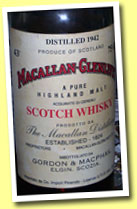 |
And
also, obligatory drum roll…
Patrick’s ‘incredible’
Macallan-Glenlivet
1942 (43%, Gordon & MacPhail,
Pinerolo, sherry wood)
 This is extremely rare, very little
distilleries were still working in
1942 as by law, all grains were to
be kept to feed the population. Derogations
were only granted to The Macallan
and, if memory serves me well, Mortlach
and Glenlivet. Nose: a wonderful fruitiness
and a perfect balance, with notes
of very old liqueurs, figs, lemon
pie, metal polish, shoe polish, honey
and the most delicate touches of peat.
Mouth: absolutely perfect once again,
and a sublime balance. Strawberry-filled
chocolates and roasted honeyed peanuts.
Comments: extreme balance, finesse
and complexity. SGP:632 –
93 points.
This is extremely rare, very little
distilleries were still working in
1942 as by law, all grains were to
be kept to feed the population. Derogations
were only granted to The Macallan
and, if memory serves me well, Mortlach
and Glenlivet. Nose: a wonderful fruitiness
and a perfect balance, with notes
of very old liqueurs, figs, lemon
pie, metal polish, shoe polish, honey
and the most delicate touches of peat.
Mouth: absolutely perfect once again,
and a sublime balance. Strawberry-filled
chocolates and roasted honeyed peanuts.
Comments: extreme balance, finesse
and complexity. SGP:632 –
93 points. |
| Now,
please look at these two labels... |
 |
The
one on the left is the bottle that
we just tried. It was bought at
Bonham’s auction house in
the UK by our friend Patrick. The
label on the right is from a Macallan
1940 that I have in my cellar (sorry,
I own no 1942) and is similar to
all old Macallans G&M Pinerolo
that were distilled around the war
and that you will find on all reputable
websites (whiskyauction and others).
Do you notice something? No? Actually,
there are many tiny differences
but the most obvious one is the
T from 'The' Macallan that's not
the same at all and if you look
closer, the whole font is different.
That's why I'm not 100% sure this
1942, on the left, is 100% genuine,
nor am I sure that it's a fake by
the way. But if it is, what’s
quite incredible is that this '1942'
is probably better than the original
bottling, if it ever existed. I
guess the clever Italians who possibly
made it used some rather old Macallan,
maybe one the best batches of the
old 8yo (rather cheap but utterly
brilliant whisky!) or of the old
12yo. Should you know more about
this kind of label variant, please
drop me a line!
|
MUSIC
- Recommended listening:
Artists: the mysterious 'Alex Donnelly'
and 'zw'
Title: Frank Zappa's Let's
Make The Water Turn Black
Please 'buy' Alex Donnelly's and
zw's music. |
 |
| |
|
July
6, 2009 |
|
 |
CONCERT
REVIEW by Nick Morgan
MOBY
Royal Festival Hall,
London, June 16th 2009 |
| One
of the many upsides of having to spend
quite a lot of time in a car driving
around Scotland is that you hear some
fantastic programmes on the radio.
A little while ago, I was captivated
by a documentary called Beat
Mining and the Vinyl Hoover, put
together by photographer and broadcaster
Toby
Amies and which opened the lid
on the world of crate diggers. This
potentially highly lucrative pastime
involves tracking down samples that
might, just might, be worth a fortune
to producers and artists. Part of
the fascination of the show was the
extent of the hidden sub-culture that
it revealed (some of the crate diggers’
blogs were aghast at just how much
of their secret world was brought
to light). But it was also enlightening
to understand just how important sampling
has become to contemporary genres
of music: it’s travelled a long
way since David Byrne and Eno experimented
with the technique on My
Life in the Bush of Ghosts in
1981. When we saw Byrne earlier in
the year, he joked that it had been
made in an age of innocence compared
with today, explaining that for legal
reasons, he would have to sing the
sampled vocal himself on ‘Help
me somebody’. Amies’ programme
began to suggest just what a murky
world it had become. And it’s
not surprising. Moby
sold nine million copies of 1999’s
Play, a record built around samples
from Alan Lomax’s field work
in the southern states of the USA
in the 1920s. |
 |
| I’m
sure Moby paid his dues (he’s
notable for giving much of his dosh
away to charity), and sure enough
artists like Bessie Jones, a sample
from whom provides the background
to ‘Honey’, get an acknowledgement
as a licensed artist, along with Boy
Blue’s recording of Joe Lee’s
Rock (‘Find my baby’)
, and Bill Landford (and the Landfordaires)
for ‘Run on’. But while
there is a general thanks to the Lomaxes,
there’s not a mention of poor
old Vera Hall, whose sampled lyric
from ‘Trouble so hard’
provided the backbone to ‘Natural
blues’, one of the big hits
for the album. In addition, I’m
not sure that the Lomax family or
Vera Hall, or the other original performers,
received much by way of royalties
when the songs were re-used in numerous
TV adverts for brands such as Calvin
Klein and American Express. Moby woudn’t
have got far without them. ‘Natural
blues’ is one of the centrepieces
in this second of 2009’s Meltdown
concerts at the Southbank Centre,
curated by Ornette Coleman. ‘Honey’
was the lengthy coda to the set. Other
songs from Play, ‘Why does my
heart feel so bad’ and ‘Porcelain’
were two of the more impressive pieces
of the evening. The latter of these
earned a similarly frenetic audience
response, particularly from the over-excited
guys in front of us; then came Moby’s
first breakthrough hit, the David
Lynch-inspired ‘Go’, appearing
to transform the RFH into a disco
under the arches on Brighton sea-front
(I swear all that was missing was
Dave Broom). Strange, you might think,
for this first night of an extensive
European tour ostensibly aimed at
promoting Moby’s new album,
Wait for Me. |
| He
did present five songs from the new
work, including opener ‘Walk
with me’, a blues sung by the
imposing Joy
Malcolm, who also sang the sampled
parts from Play herself - no samples
in use tonight. Malcolm was joined
on vocals by the more delicate Kelli
Scarr, who sang (among others)
new tracks ‘Pale Horses’
and ‘JLFT’. The latter
was introduced by Mr M with the strange
boast that it was inspired "by
the vast majority of my friends in
New York, who have all been heroin
addicts". For much of this time,
Moby chose to concentrate on guitar,
where he showed a surprising mastery
of power chords, which when combined
with the amplified string trio, occasionally
produced a wall of sound that even
Phil Spector must have heard from
his prison cell in Corcoran, California. |
|
 |
|
He occasionally took the coveted RFH
Steinway (“how could I have
a piano the size of a small car in
my small New York apartment?”)
and even sang; brave, given the relative
weakness and tunelessness of his voice.
Only once did he really hit the synthesiser
for ‘Go’, and even then,
no sooner cranked up than he chose
to move over to play the congas with
abandon instead. So it was an odd
and eclectic set of the rather laid-bare
and perhaps self-indulgent new material
rubbing shoulders with highlights
of the old, with little doubt as to
where the audience’s heart lay.
We even had a couple of covers: Joy
Division’s ‘New dawn fades’,
and ‘Helpless’ which was
wrongly attributed to CSN&Y, rather
than simply Y. Despite all this, the
audience would probably have been
happier, not to mention more exhausted,
if he’d played ‘Go’
all night. |
| Oh
yes. For the record, Mr Coleman, who
had personally called Moby and invited
him to perform in the series of concerts,
didn’t manage to show up on
stage, as some of us (including Moby
apparently) had rather hoped he might.
– Nick Morgan (photographs
by Kate) |
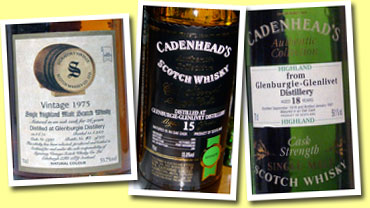 |
TASTING
THREE GLENBURGIE |
Glenburgie
26 yo 1975/2002 (53.7%, Signatory,
cask #5990, 207 bottles)
 Colour: gold. Nose: fresh and very
‘natural’, with quite
some vanilla, green apples, cut grass,
walnut skin and fresh almonds. Good
quality it seems even if not really
characterful. Slightly mineral as
well (broken rocks). With water: superb!
It really explodes with notes of soft
spices and all things from a pastry
shop (cakes, fudges…) and quite
some vanilla. And baklavas, with these
distinct notes of orange blossom water.
Top notch! Mouth (neat): sweet and
fruity, with just a little cough syrup
in the background. Pineapple drops,
Williams pear eau-de-vie, grenadine,
all that at cask strength. Big body!
With water: once again, it opens up
with water and does ‘the peacock’s
tail’. Marmalade and various
soft spices. Quite some ginger. Finish:
long, on orange flavoured marzipan
(by the way, does that exist?) Comments:
a great dram from a rather low-profile
distillery, signed Signatory. SGP:552
- 90 points. (ands thank
you, Mike)
Colour: gold. Nose: fresh and very
‘natural’, with quite
some vanilla, green apples, cut grass,
walnut skin and fresh almonds. Good
quality it seems even if not really
characterful. Slightly mineral as
well (broken rocks). With water: superb!
It really explodes with notes of soft
spices and all things from a pastry
shop (cakes, fudges…) and quite
some vanilla. And baklavas, with these
distinct notes of orange blossom water.
Top notch! Mouth (neat): sweet and
fruity, with just a little cough syrup
in the background. Pineapple drops,
Williams pear eau-de-vie, grenadine,
all that at cask strength. Big body!
With water: once again, it opens up
with water and does ‘the peacock’s
tail’. Marmalade and various
soft spices. Quite some ginger. Finish:
long, on orange flavoured marzipan
(by the way, does that exist?) Comments:
a great dram from a rather low-profile
distillery, signed Signatory. SGP:552
- 90 points. (ands thank
you, Mike) |
Glenburgie-Glenlivet
15 yo 1993/2008 (55.8%, Cadenhead's,
Authentic Collection, 200 bottles)
 I always found it funny that Cadenhead
would keep using the ‘Glenlivet’
suffix, I guess it’s what was
stencilled on the cask’s head.
Colour: straw. Nose: obviously younger
than the 1975, that is to say more
on cut apples and pears, but there’s
also a little more smoke. Other than
that we get the same whiffs of newly
cut grass. Hay. With water: not many
changes, a little more paraffin. Pleasant
but far from the Signatory’s
magnificent development. Lacks ageing?
Mouth (neat): another typical fairly
young Speysider at cask strength.
Pears and apple peeling galore plus
a little bubblegum, all that coated
with some kind of herbs liqueur. In
short, plants and fruits. With water:
gets more vegetal and, good news,
much closer to the Signatory. Same
notes of marmalade and spices. Finish:
long, half fruity, half grassy. A
tad bitter (walnut skin). Comments:
less easy going and luscious than
the Signatory but still good. SGP:451
- 85 points.
I always found it funny that Cadenhead
would keep using the ‘Glenlivet’
suffix, I guess it’s what was
stencilled on the cask’s head.
Colour: straw. Nose: obviously younger
than the 1975, that is to say more
on cut apples and pears, but there’s
also a little more smoke. Other than
that we get the same whiffs of newly
cut grass. Hay. With water: not many
changes, a little more paraffin. Pleasant
but far from the Signatory’s
magnificent development. Lacks ageing?
Mouth (neat): another typical fairly
young Speysider at cask strength.
Pears and apple peeling galore plus
a little bubblegum, all that coated
with some kind of herbs liqueur. In
short, plants and fruits. With water:
gets more vegetal and, good news,
much closer to the Signatory. Same
notes of marmalade and spices. Finish:
long, half fruity, half grassy. A
tad bitter (walnut skin). Comments:
less easy going and luscious than
the Signatory but still good. SGP:451
- 85 points. |
Glenburgie-Glenlivet
18 yo 1978/1997 (59.1%, Cadenhead)
 From the series that we sometimes
call ‘small white label’.
Colour: white wine. Nose: much more
austere than the 1975 and 1993, extremely
mineral and grassy. No fruits this
time, a little hard. With water: hello?
A little more smoke but that’s
pretty all. Wet hay, vase water. Mouth
(neat): starts extremely estery/fruity
this time, water is obligatory even
if it’s very clean spirit. With
water: once again, water does wonders
on this Glenburgie that gets more
orangey (marmalade) and beautifully
spicy. Ginger, lemon balm, vanilla
crème. Finish: medium long,
clean, with quite some marzipan once
again. Comments: a bit hard when undiluted
but gets very good with water. Amphibious
malt? SGP:451 - 83 points.
From the series that we sometimes
call ‘small white label’.
Colour: white wine. Nose: much more
austere than the 1975 and 1993, extremely
mineral and grassy. No fruits this
time, a little hard. With water: hello?
A little more smoke but that’s
pretty all. Wet hay, vase water. Mouth
(neat): starts extremely estery/fruity
this time, water is obligatory even
if it’s very clean spirit. With
water: once again, water does wonders
on this Glenburgie that gets more
orangey (marmalade) and beautifully
spicy. Ginger, lemon balm, vanilla
crème. Finish: medium long,
clean, with quite some marzipan once
again. Comments: a bit hard when undiluted
but gets very good with water. Amphibious
malt? SGP:451 - 83 points. |
| |
|
July
4, 2009 |
|
 |
 |
TASTING
– THREE 1970 SPEYSIDERS (undisclosed) |
Speyside
39 yo 1970/2009 (54.4%, Perfect Dram,
first fill oloroso, 240 bottles)  Colour: dark amber. Nose: classic!
Powerful but ‘nosable’,
first bursting with whiffs of hot
chocolate and getting then rather
smoky, toasty and flinty. Quite some
gunpowder and struck matches (but
no cooked eggs). A lot of orange liqueur
too. With water: it got fantastic,
much more approachable but still elegant.
Espresso, orange cake, roasted nuts,
quince jelly and toasted bread. Mouth
(neat): powerful again, starting fruitier
than on the nose. All on fruitcake
actually, with figs and prunes leading
the pack, then Cointreau, kirsch and
liquorice. The expression ‘full
bodied’ must have been invented
for this whisky. With water: some
winey notes do arise (blackcurrant
liqueur). Hard to tame, even at 25%
vol. it’s still pretty much
alive. ‘Undrownable’ ;-).
Finish: long, punchy, it just wouldn’t
leave. Slight roughness (farmer’s
fruit spirit ;-). Comments: amazing
that these oldies from that distillery
remain so fresh and lively. An ode
to old age. SGP:543 - 90 points.
Colour: dark amber. Nose: classic!
Powerful but ‘nosable’,
first bursting with whiffs of hot
chocolate and getting then rather
smoky, toasty and flinty. Quite some
gunpowder and struck matches (but
no cooked eggs). A lot of orange liqueur
too. With water: it got fantastic,
much more approachable but still elegant.
Espresso, orange cake, roasted nuts,
quince jelly and toasted bread. Mouth
(neat): powerful again, starting fruitier
than on the nose. All on fruitcake
actually, with figs and prunes leading
the pack, then Cointreau, kirsch and
liquorice. The expression ‘full
bodied’ must have been invented
for this whisky. With water: some
winey notes do arise (blackcurrant
liqueur). Hard to tame, even at 25%
vol. it’s still pretty much
alive. ‘Undrownable’ ;-).
Finish: long, punchy, it just wouldn’t
leave. Slight roughness (farmer’s
fruit spirit ;-). Comments: amazing
that these oldies from that distillery
remain so fresh and lively. An ode
to old age. SGP:543 - 90 points. |
Ballindalloch
1970/2009 (54.7%, The Whisky Cask,
sherry butt)
 Colour: dark amber. Nose: mulled wine!
Indeed, mulled wine at cask strength,
or maybe even sangria. You guessed
it, this one is much more winey and
even vinous, with notes of crushed
raspberries and strawberries plus
Chinese anise, cinnamon and cloves.
The whole is clean and, I must say,
rather spectacular, but you have to
like wine. Keeps changing, getting
more herbal (thyme) and very resinous,
which isn’t unusual with these
old whiskies. Propolis. The vinosity
almost vanished. With water: cough
syrup! And a great one at that –
but once again, you have to like this
profile. Faint waxiness. Mouth (neat):
thick and oily and directly resinous.
Fir buds liqueur, strong cough drops,
Jägermeister and even Underberg.
Rather extreme in its own style. With
water: same but rounder. A tad paraffiny.
Finish: long, kind of silkily resinous,
reminding me of some mint-flavoured
oriental sweets. Comments: the wood
did a lot of work here and this profile
is maybe a little off-the-tracks,
but it’s spectacular and very,
very good provided you like the style.
SGP:571 - 89 points.
Colour: dark amber. Nose: mulled wine!
Indeed, mulled wine at cask strength,
or maybe even sangria. You guessed
it, this one is much more winey and
even vinous, with notes of crushed
raspberries and strawberries plus
Chinese anise, cinnamon and cloves.
The whole is clean and, I must say,
rather spectacular, but you have to
like wine. Keeps changing, getting
more herbal (thyme) and very resinous,
which isn’t unusual with these
old whiskies. Propolis. The vinosity
almost vanished. With water: cough
syrup! And a great one at that –
but once again, you have to like this
profile. Faint waxiness. Mouth (neat):
thick and oily and directly resinous.
Fir buds liqueur, strong cough drops,
Jägermeister and even Underberg.
Rather extreme in its own style. With
water: same but rounder. A tad paraffiny.
Finish: long, kind of silkily resinous,
reminding me of some mint-flavoured
oriental sweets. Comments: the wood
did a lot of work here and this profile
is maybe a little off-the-tracks,
but it’s spectacular and very,
very good provided you like the style.
SGP:571 - 89 points. |
Glenfairytales
38 yo 1970/2008 (54.8%, Whisky Tales,
500ml)  Colour: dark amber. Nose: this one
started rather similar to the ‘Whisky
Cask’, with quite some mulled
wine but it suddenly makes a U-turn
and gets then much closer to the ‘Perfect
Dram’ without ever reaching
its smokiness and dryness. Sort of
between both, which is good news.
With water: same, somewhere between
the two. Dried figs and After Eights
plus a little grenadine syrup. Beautiful.
Mouth (neat): now we’re extremely
close to the Whisky Cask. Big resinous
notes and just a little new kirsch
(that just ran out of the still).
Very heavy, very concentrated. With
water: oh well, it’s rather
different from the two others at this
point. More blackberry jam, raspberries,
other berries… The minty and
resinous notes are well there but
got more discreet. Maybe just some
tiny sweetish notes in the background,
supermarket strawberry lollipops,
bubblegum and such. Finish: long,
in keeping with the rest. Comments:
another restless oldie from that distillery.
Good stuff. SGP:561 - 88 points.
Colour: dark amber. Nose: this one
started rather similar to the ‘Whisky
Cask’, with quite some mulled
wine but it suddenly makes a U-turn
and gets then much closer to the ‘Perfect
Dram’ without ever reaching
its smokiness and dryness. Sort of
between both, which is good news.
With water: same, somewhere between
the two. Dried figs and After Eights
plus a little grenadine syrup. Beautiful.
Mouth (neat): now we’re extremely
close to the Whisky Cask. Big resinous
notes and just a little new kirsch
(that just ran out of the still).
Very heavy, very concentrated. With
water: oh well, it’s rather
different from the two others at this
point. More blackberry jam, raspberries,
other berries… The minty and
resinous notes are well there but
got more discreet. Maybe just some
tiny sweetish notes in the background,
supermarket strawberry lollipops,
bubblegum and such. Finish: long,
in keeping with the rest. Comments:
another restless oldie from that distillery.
Good stuff. SGP:561 - 88 points. |
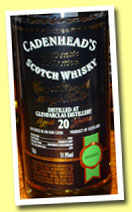 |
While
I’m at it, another recent Speysider:
Glenfarclas
20 yo 1988/2009 (51.9%, Cadenhead,
bourbon hogshead, 203 bottles)
 Probably much less cask influence
to be expected in this one, I believe
bourbon hoggies aren’t commonly
bottled as single casks at Glenfarclas.
Colour: white wine. Nose: indeed,
this one has nothing to do with the
old sherritastics, it even noses rather
younger than 20. Very classy ‘naked’
young Speysider all on sweet apples,
greengages, a little sweetened lemon
juice, notes of vanilla crème,
a little butterscotch, walnut cake,
Demerara sugar… It’s rather
delicate, very elegant. No water needed
I think. Mouth: very good, very sweet,
very clean, very fruity and…
very young. It tastes more or less
like a good 10 yo Miltonduff if I
may say so. Apple juice, hints of
Turkish delights (rose-flavoured,
obviously), even pear juice, a little
nougat… Finish: medium long,
on the same kind of flavours. Aftertaste
on fruit spirit. Comments: I like
these young Speysiders when they’re
as clean as this one… Except
that the latter is not exactly young.
Oh well… SGP:641 - 84
points.
Probably much less cask influence
to be expected in this one, I believe
bourbon hoggies aren’t commonly
bottled as single casks at Glenfarclas.
Colour: white wine. Nose: indeed,
this one has nothing to do with the
old sherritastics, it even noses rather
younger than 20. Very classy ‘naked’
young Speysider all on sweet apples,
greengages, a little sweetened lemon
juice, notes of vanilla crème,
a little butterscotch, walnut cake,
Demerara sugar… It’s rather
delicate, very elegant. No water needed
I think. Mouth: very good, very sweet,
very clean, very fruity and…
very young. It tastes more or less
like a good 10 yo Miltonduff if I
may say so. Apple juice, hints of
Turkish delights (rose-flavoured,
obviously), even pear juice, a little
nougat… Finish: medium long,
on the same kind of flavours. Aftertaste
on fruit spirit. Comments: I like
these young Speysiders when they’re
as clean as this one… Except
that the latter is not exactly young.
Oh well… SGP:641 - 84
points. |
| |
|
July
2, 2009 |
|
 |
| SPEED
TASTING – FIVE YOUNG MACALLANS
(some old) |
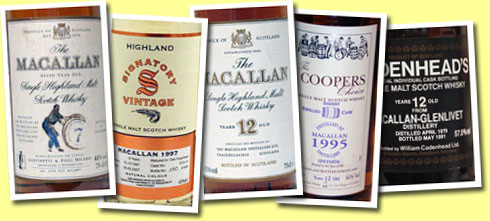 |
Macallan
7yo (40%, OB Giovinetti & Figli
import, Italy, +/-1985, 75cl)
 The 7 was getting rather poor in its
last years but this should be better,
even if the older 8 was in a different
league (many fakes made in Italy actually
contain that old 8yo, which explains
why they’re so good and why
nobody (even at very high places)
never complained). Enough said. Colour:
gold. Nose: rather big but unusually
grassy for The Macallan, with a combination
of apple peeling, walnut skin and
plain paraffin. Metal polish, sour
apples, wet clay. Not very aromatic
to say the least and far from the
good 12 or even 10 that were also
available at the time. Mouth: very
bizarre. It’s not that it’s
unpleasant but some notes of candle
wax – not too nice on the palate
– plus something such as rotting
oranges just don’t work. Varnish.
Finish: medium long, more on bitter
‘things’ (leaves, fruit
skins and so on). Comments: it’s
not an OBE that went wrong. Not the
best old Macallan for sure but some
parts are interesting. SGP:362
- 72 points.
The 7 was getting rather poor in its
last years but this should be better,
even if the older 8 was in a different
league (many fakes made in Italy actually
contain that old 8yo, which explains
why they’re so good and why
nobody (even at very high places)
never complained). Enough said. Colour:
gold. Nose: rather big but unusually
grassy for The Macallan, with a combination
of apple peeling, walnut skin and
plain paraffin. Metal polish, sour
apples, wet clay. Not very aromatic
to say the least and far from the
good 12 or even 10 that were also
available at the time. Mouth: very
bizarre. It’s not that it’s
unpleasant but some notes of candle
wax – not too nice on the palate
– plus something such as rotting
oranges just don’t work. Varnish.
Finish: medium long, more on bitter
‘things’ (leaves, fruit
skins and so on). Comments: it’s
not an OBE that went wrong. Not the
best old Macallan for sure but some
parts are interesting. SGP:362
- 72 points. |
Macallan
11 yo 1997/2008 (43%, Signatory, hogsheads
#929-930, 797 bottles)  Colour: white wine.
Nose: this one screams ‘young
Speysider’ with a lot of apple
juice, pear juice and a little beer.
Also whiffs of wood smoke plus a little
ginger tonic. Simple but not unpleasant
at all. Mouth: simple but clean, very
fruity, nicely balanced and very ‘natural’.
Not much cask influence. A little
bubblegum. Finish: medium long, on
oranges and a little ginger. Comments:
good spirit from a rather inactive
cask, at an easy drinking strength.
A few ice cubes (or better yet, chilled
rocks) would work. SGP:431
- 80 points.
Colour: white wine.
Nose: this one screams ‘young
Speysider’ with a lot of apple
juice, pear juice and a little beer.
Also whiffs of wood smoke plus a little
ginger tonic. Simple but not unpleasant
at all. Mouth: simple but clean, very
fruity, nicely balanced and very ‘natural’.
Not much cask influence. A little
bubblegum. Finish: medium long, on
oranges and a little ginger. Comments:
good spirit from a rather inactive
cask, at an easy drinking strength.
A few ice cubes (or better yet, chilled
rocks) would work. SGP:431
- 80 points. |
Macallan
12yo (43%, OB, Screw Cap, Imported
by ETS Couin, France, +/-1989)
 Colour: amber. Nose: this
popular old version is in a completely
different league, with the typical
sherry notes upfront as well as the
same kind of grassiness as in the
7, only much more refined and elegant.
Whiffs of old books (no mouldiness,
though) and then old roses and high-end
perfume (your pick). A lady’s
perfume of course. Quite some smoke
again, much more smoke than in recent
bottlings for sure. Coal stove. Beautiful
nose. Mouth: oh yes, this is nice
whisky. It’s not very big but
complex and kind of ‘antiquated’,
with some sweet/leathery notes, crystallised
orange zests, marmalade, Indian soft
spice mix (we’ll spare you the
maltoporn here), deep-roasted coffee,
praline, herbal tea (a mix again)…
Beautiful palate, very complex. Many
whisky lovers came to maltmania with
this one – no wonder! Finish:
medium long but still complex, maybe
a little more ‘toasted’
and smoky. Comments: utterly classic
and classy. SGP:553 - 89 points.
(and thank you, Konstantin)
Colour: amber. Nose: this
popular old version is in a completely
different league, with the typical
sherry notes upfront as well as the
same kind of grassiness as in the
7, only much more refined and elegant.
Whiffs of old books (no mouldiness,
though) and then old roses and high-end
perfume (your pick). A lady’s
perfume of course. Quite some smoke
again, much more smoke than in recent
bottlings for sure. Coal stove. Beautiful
nose. Mouth: oh yes, this is nice
whisky. It’s not very big but
complex and kind of ‘antiquated’,
with some sweet/leathery notes, crystallised
orange zests, marmalade, Indian soft
spice mix (we’ll spare you the
maltoporn here), deep-roasted coffee,
praline, herbal tea (a mix again)…
Beautiful palate, very complex. Many
whisky lovers came to maltmania with
this one – no wonder! Finish:
medium long but still complex, maybe
a little more ‘toasted’
and smoky. Comments: utterly classic
and classy. SGP:553 - 89 points.
(and thank you, Konstantin)
|
Macallan
1995/2008 (46%, Coopers Choice, refill
sherry)  Colour: straw. Nose: it is probably
not as complex and thrilling as the
old official 12 but some parts are
well here, such as the smoke (unexpected),
the fine sherry, then a little leather
and old books again (or old wardrobe
in the attic), oranges, a little caramel…
A perfect nose for a recent 12/13yo
Macallan and one that’s rather
more ‘official’ than ‘independent’.
More smoke and even flints after a
while. Mouth: it’s quite amazing
how this one is similar to the old
12 again. Maybe a tiny-wee-bit simpler
(and punchier) but other than that,
we’re in presence of very similar
malts. Excellent. Finish: long, a
little more on caramel crème,
toffee and fudge. Comments: excellent
cask selection by the Coopers’
Choice, closer to the old official
wonders (‘though less smoky)
than to the recent official…
bottlings. SGP:552 - 88 points.
Colour: straw. Nose: it is probably
not as complex and thrilling as the
old official 12 but some parts are
well here, such as the smoke (unexpected),
the fine sherry, then a little leather
and old books again (or old wardrobe
in the attic), oranges, a little caramel…
A perfect nose for a recent 12/13yo
Macallan and one that’s rather
more ‘official’ than ‘independent’.
More smoke and even flints after a
while. Mouth: it’s quite amazing
how this one is similar to the old
12 again. Maybe a tiny-wee-bit simpler
(and punchier) but other than that,
we’re in presence of very similar
malts. Excellent. Finish: long, a
little more on caramel crème,
toffee and fudge. Comments: excellent
cask selection by the Coopers’
Choice, closer to the old official
wonders (‘though less smoky)
than to the recent official…
bottlings. SGP:552 - 88 points.
|
Macallan
12yo 1979/1991 (57%, Cadenhead's,
dumpy black label)
 One of the very last bottlings in
this ‘dumpy black label’
series. Sob… Colour: full gold.
Nose: oh no, I had hoped the old 12
or the Coopers’ would win this
little battle but with these sneaky
black dumpies, the dirtiest tricks
may be played at the very last minutes
and once again, it’s what seems
to happen here, at least on the nose.
Same profile as the old 12 but bigger
and more profound, a tad drier, maybe
more austere but also (even) more
elegant. More herbal too (parsley,
lovage and sage). And quite some smoke,
both wood and coal. With water: added
whiffs of wet wool, that’s all.
Mouth (neat): creamy and unexpectedly
lemony. Amazingly lemony in fact,
and disturbingly so as well because
it’s becoming kind of chemical
(cheapo readymade lime juice.) Something
chalky as well, and also a little
salt. Not too good and possibly flawed
here. Cardboardy. With water: that
didn’t work. And pipe juice?
(only pipe smokers or former pipe
smokers will understand – good
for the others.) Finish: long but
– cough, cough – still
oddly lemony and chalky. Comments:
fantastic nose but a flawed palate.
Too bad. SGP:641 - 79 points.
One of the very last bottlings in
this ‘dumpy black label’
series. Sob… Colour: full gold.
Nose: oh no, I had hoped the old 12
or the Coopers’ would win this
little battle but with these sneaky
black dumpies, the dirtiest tricks
may be played at the very last minutes
and once again, it’s what seems
to happen here, at least on the nose.
Same profile as the old 12 but bigger
and more profound, a tad drier, maybe
more austere but also (even) more
elegant. More herbal too (parsley,
lovage and sage). And quite some smoke,
both wood and coal. With water: added
whiffs of wet wool, that’s all.
Mouth (neat): creamy and unexpectedly
lemony. Amazingly lemony in fact,
and disturbingly so as well because
it’s becoming kind of chemical
(cheapo readymade lime juice.) Something
chalky as well, and also a little
salt. Not too good and possibly flawed
here. Cardboardy. With water: that
didn’t work. And pipe juice?
(only pipe smokers or former pipe
smokers will understand – good
for the others.) Finish: long but
– cough, cough – still
oddly lemony and chalky. Comments:
fantastic nose but a flawed palate.
Too bad. SGP:641 - 79 points. |
| PETE
McPEAT AND JACK WASHBACK on holidays
in St Tropez |
| |
|
July
1, 2009 |
|
 |
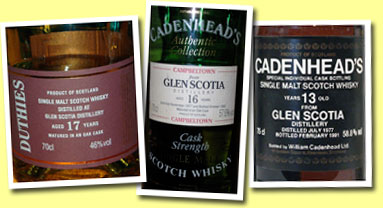 |
TASTING
– ANOTHER THREE GLEN SCOTIA
(a redemption in my book?) |
| We
had quite a few disastrous experiences
with Glen Scotia in recent times but
I know that the humble Campbeltown
distillery can be great, so just like
Boileau advised, let’s ‘twenty
times on the loom, put back our work…’ |
Glen
Scotia 17 yo (46%, Duthies, +/- 2009)
 Colour: straw. Nose: light and grassy,
spirity, austere, inexpressive, faintly
smoky… Also hints of linseed
oil, graphite, mustard… Slivovitz…
It’s not that it’s ugly
whisky, it just doesn’t offer
much pleasure. Mouth: ha-ha, this
is better! It’s still very grassy
but the heavy notes of white rum and
citrus (mojito!) make it rather enjoyable.
It’s also rather leafy, still
mustardy, peppery… Some character,
no doubt. Finish: rather long, peppery
and ‘green’ (cider apples).
Comments: interesting malt in its
big grassiness. And no flaws that
I can detect this time (provided what
I think is a flaw is actually a flaw,
of course). SGP:261 –
83 points.
Colour: straw. Nose: light and grassy,
spirity, austere, inexpressive, faintly
smoky… Also hints of linseed
oil, graphite, mustard… Slivovitz…
It’s not that it’s ugly
whisky, it just doesn’t offer
much pleasure. Mouth: ha-ha, this
is better! It’s still very grassy
but the heavy notes of white rum and
citrus (mojito!) make it rather enjoyable.
It’s also rather leafy, still
mustardy, peppery… Some character,
no doubt. Finish: rather long, peppery
and ‘green’ (cider apples).
Comments: interesting malt in its
big grassiness. And no flaws that
I can detect this time (provided what
I think is a flaw is actually a flaw,
of course). SGP:261 –
83 points. |
Glen
Scotia 16 yo 1977/1993 (57.60%, Cadenhead,
Authentic Collection)
 Colour: gold. Nose: the same kind
of grassy and flinty notes as in the
Duthies but it seems that this one
is rather cleaner and straighter.
Apple peelings. Let’s try to
bring it round with a little water.
With water: well, I wouldn’t
say it got more expressive but there
are some pleasant whiffs of menthol
and eucalyptus now. Mouth (neat):
starts a bit acrid but just like the
Duthies, it’s nicer on the palate
than on the nose, even at 57%+. Herbs
liqueur, a little wasabi, green apple
liqueur like they make in Spain and
quite possibly a little peat. With
water: same notes, only smoother and
rounder. Marzipan. Very good I must
say. Finish: long, with a little salt
and quite some mint flavoured green
tea. Comments: not sexy but full and
kind of closer to its high-profile
neighbour starting with a S. SGP:452
- 86 points (and many
thanks, Tomislav)
Colour: gold. Nose: the same kind
of grassy and flinty notes as in the
Duthies but it seems that this one
is rather cleaner and straighter.
Apple peelings. Let’s try to
bring it round with a little water.
With water: well, I wouldn’t
say it got more expressive but there
are some pleasant whiffs of menthol
and eucalyptus now. Mouth (neat):
starts a bit acrid but just like the
Duthies, it’s nicer on the palate
than on the nose, even at 57%+. Herbs
liqueur, a little wasabi, green apple
liqueur like they make in Spain and
quite possibly a little peat. With
water: same notes, only smoother and
rounder. Marzipan. Very good I must
say. Finish: long, with a little salt
and quite some mint flavoured green
tea. Comments: not sexy but full and
kind of closer to its high-profile
neighbour starting with a S. SGP:452
- 86 points (and many
thanks, Tomislav) |
Glen
Scotia 13 yo 1977/1991 (58.8%, Cadenhead's
Dumpy, Black Label, 75cl)  Colour:
old. Nose: not many differences with
the 16yo. Maybe even more ‘narrowly’
grassy. With water: this is funny,
it went in the opposite direction
when compared with the 16yo. Much
more buttery at first, then a tad
resinous . Whiffs of wet moss, fern
and mushrooms. Slight mouldiness.
Mouth (neat): this one is obviously
from the same batch as the 16yo. Same
profile, a tad rougher and also fruitier
(in other words, even more Spanish
apple liqueur). With water: oh, it’s
the same whisky as the 16yo again,
which is great news. Finish: long,
similar to the 16, maybe a tad peatier
and more herbal. Comments: a big dram
with quite some peat, globally a little
closer to its high-profile neighbour
starting with a L (made at the S.
distillery). SGP:353 - 84
points.
Colour:
old. Nose: not many differences with
the 16yo. Maybe even more ‘narrowly’
grassy. With water: this is funny,
it went in the opposite direction
when compared with the 16yo. Much
more buttery at first, then a tad
resinous . Whiffs of wet moss, fern
and mushrooms. Slight mouldiness.
Mouth (neat): this one is obviously
from the same batch as the 16yo. Same
profile, a tad rougher and also fruitier
(in other words, even more Spanish
apple liqueur). With water: oh, it’s
the same whisky as the 16yo again,
which is great news. Finish: long,
similar to the 16, maybe a tad peatier
and more herbal. Comments: a big dram
with quite some peat, globally a little
closer to its high-profile neighbour
starting with a L (made at the S.
distillery). SGP:353 - 84
points. |
MUSIC
- Recommended listening:
Artist: more French chanson with
Serge
Reggiani
Title: the very bittersweet Votre
fille a vingt ans (Your daughter
is twenty)
Please buy Serge Reggiani's music. |
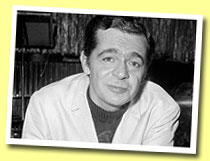 |
Check
the index of all entries:
Whisky
Music
Nick's Concert
Reviews
|
 |
 |
 |
|
| |
Best
malts I had these weeks - 90+
points only - alphabetical:
Glenburgie
26 yo 1975/2002 (53.7%,
Signatory, cask #5990, 207 bottles)
Macallan
18 yo 1966 (43%, OB, +/-1984)
Macallan
41 yo 1949/1990 (40.4%, Milroys of
Soho, Oak Wood)
Macallan-Glenlivet
1942 (43%, Gordon & MacPhail, Pinerolo,
sherry wood)
Old
Pulteney 30 yo (44%, OB, 2009)
Speyside
39 yo 1970/2009 (54.4%, Perfect Dram,
first fill oloroso, 240 bottles)


|
| |
|
|



